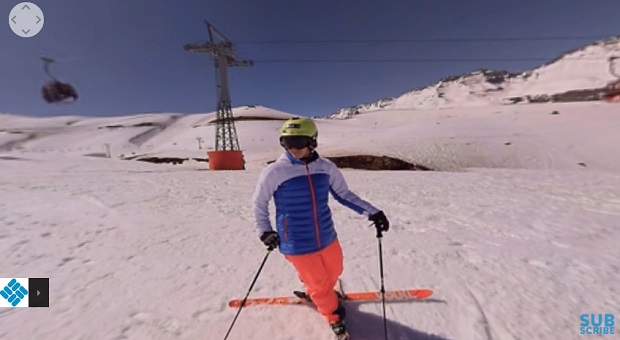For brands, is 360 video worth it? The format is potentially revolutionary, but do 360 video ads actually drive more engagement than standard ads? Google partnered with Columbia Sportswear to find out.

The challenge
The promise of immersive storytelling with 360 video has led brands to experiment with the format. But what can 360 video really do for a brand? In the context of advertising, does it ensure higher viewer metrics?
To answer these questions, Google partnered with Columbia Sportswear to create an ad campaign around two US Olympic skiers enjoying an epic season in Chile.
In addition to Columbia's marketing team and in-house photographers, the brand enlisted the help of 360 Labs—a firm that's been playing in 360 since the earliest Street View days—and a team of fearless Chilean ski photographers.
The solution
Key aspects of the experiment included:
• Created two similar 60-second campaigns using TrueView
• Both included CTAs that drove to an extended version
• Compared metrics including view-through rate, viewer retention and “interaction rate” (dragging video around)
• Both 60-second ads tested remained unlisted throughout the experiment
The narrative setup for the ads was simple: A veteran skier, Hannah Kearney, and a rising star, Keaton McCargo, come together to train and learn from each other. We wanted the audience to feel like they were on the slopes with the skiers—sensing how Hannah and Keaton take on a mogul course, for instance, or hockey stop next to the camera rig.
The standard version of the ad (and the extended cut) was visually framed around the skiers, with aerial and wide-angle shots of their runs and the landscape.
The 360 version of the ad (and the longer version) planted the audience within the terrain, allowing viewers to explore independently. Both the standard and 360 ads were narrated by Hannah and Keaton.
The results
Finding 1: 360 in-stream ads DON'T get more views
- Prediction: View-through rates and watch time for the short 360 in-stream ads would be better than the standard video campaign.
False: 360 in-stream ad underperformed the standard ad on view-through rate, across desktop and mobile. The 360 video ad had a lower retention rate than the standard ad.
Conclusion: Viewers aren't always in the mood to interact with 360 video if they're primarily watching standard video.
Finding 2: 360 in-stream ads DO drive more engagement
- Prediction: 360 video motivates viewers to watch more and interact
True: The 360 ad had a higher click-through rate, meaning that viewers were more interested in checking out the full-length version of the video.
Conclusion: As a promo for the longer video, the 360 version of the ad worked extremely well, and better than the standard version.
Finding 3: 360 ads get more clicks in less time
- Prediction: The 360 interaction rate will be higher than the view-through rates for the 60-second 360 ad.
True: 360 ad drove engagement via interactions even if people didn't watch 30 seconds or more.
Conclusion: VR ads get more clicks in less view time than standard ads
Finding 4: 360 ads more likely to build loyalty
- Assumption: 360 video would build more loyalty, driving viewers to share, subscribe, and view other videos
True: 360 ad drove 41% more earned actions than standard ad. It also drove more engagement with Columbia's YouTube channel.
Conclusion: The 360 ad trounced the standard ad on all the earned action metrics, including views, shares, and subscribes.
Finding 5: 360 ads encourage URL sharing on other channels
- Assumption: Only way a viewer could get to a longer piece was to click from the ads. Expected the views for the longer 360 piece to match (or be lower than) the clicks for the 360 shorter ad.
False: People who saw the longer 360 piece were actually copying the URL to share directly with others. In fact, messaging apps like WhatsApp and iOS messenger were listed among the traffic sources for the 360 version—but not for the standard version. The full-length 360 video also had a 46% higher view count at the end of the experiment than the standard full-length piece.
Conclusion: The 360 ad was a more efficient buy since its cost-per-view was lower when organic and paid views were combined.